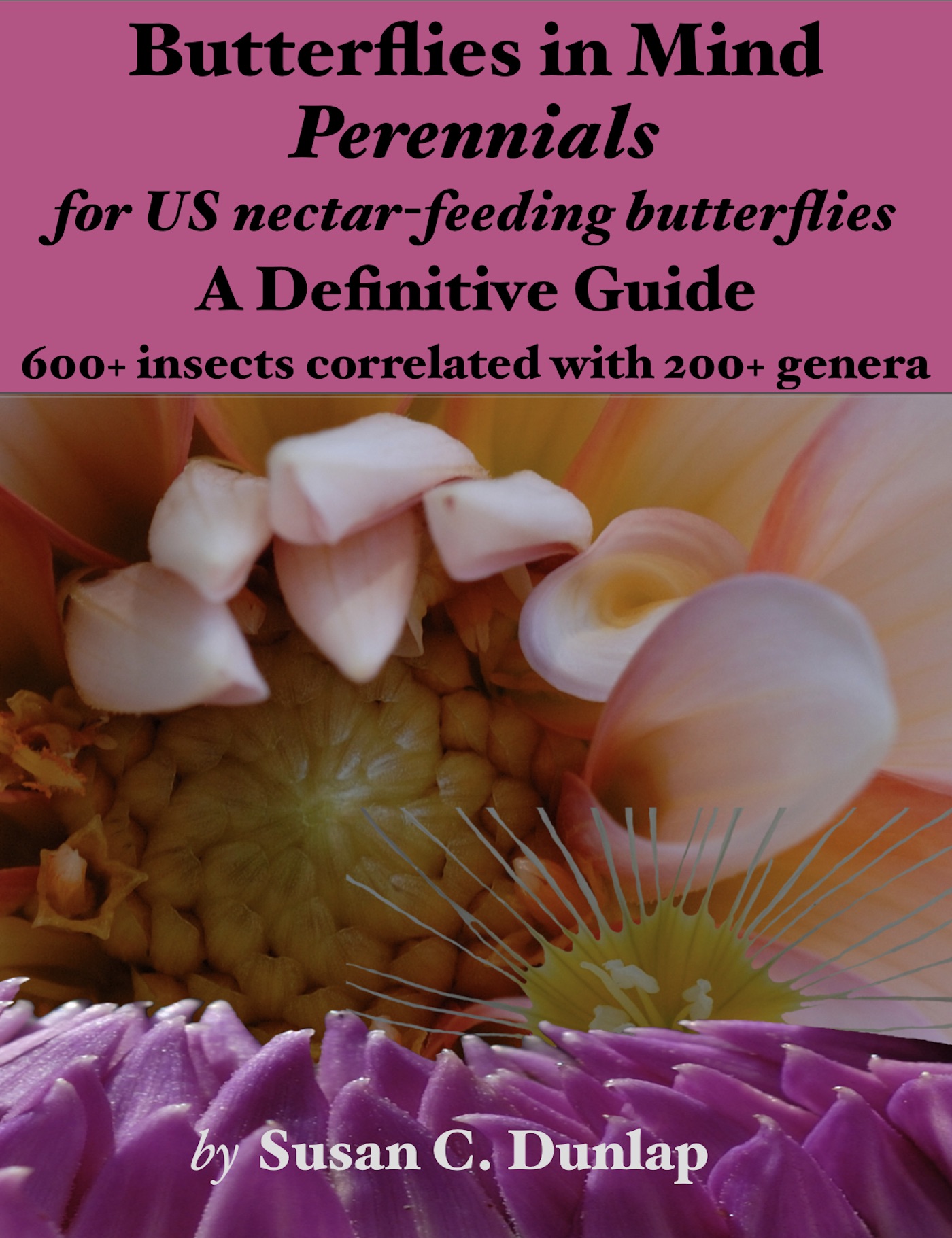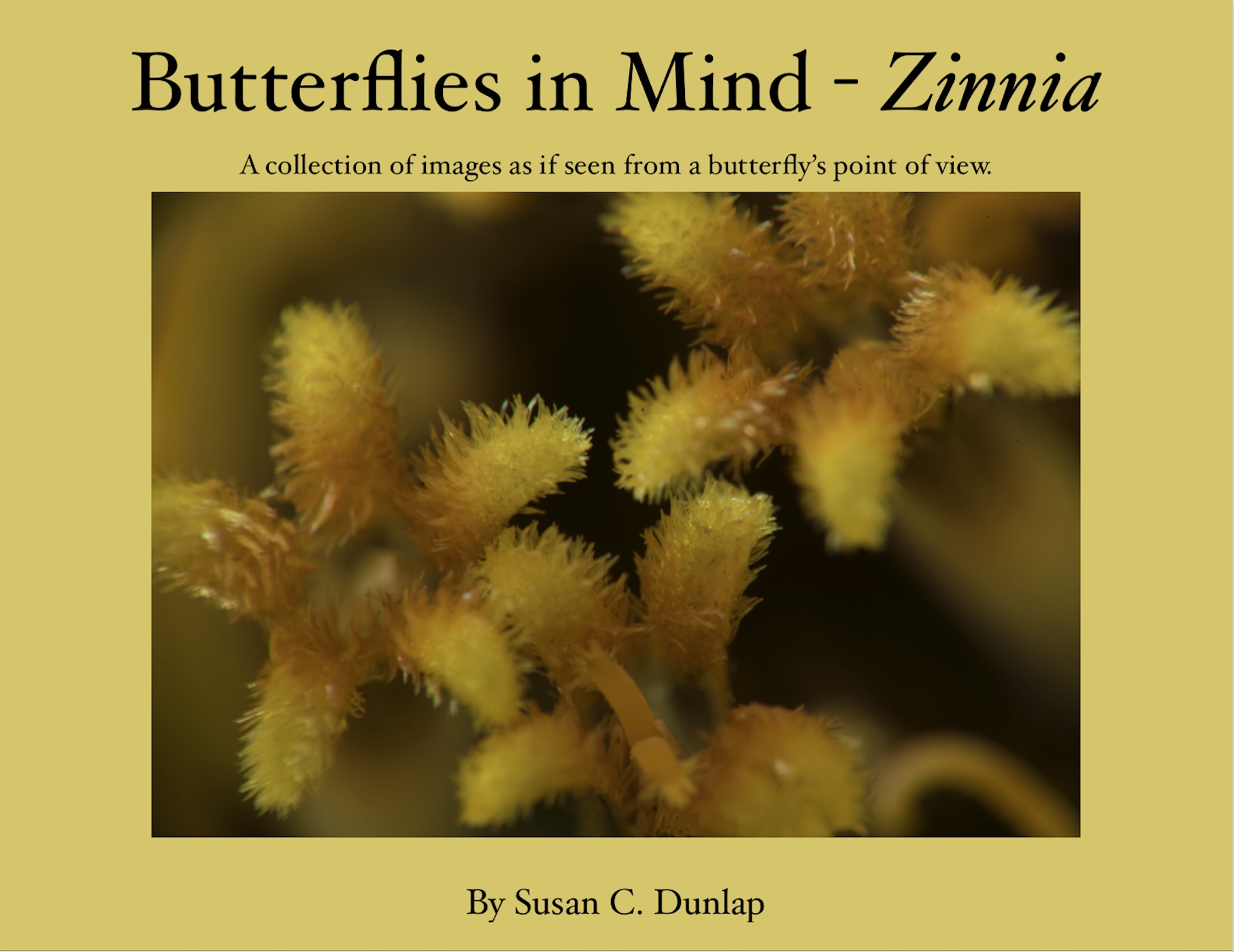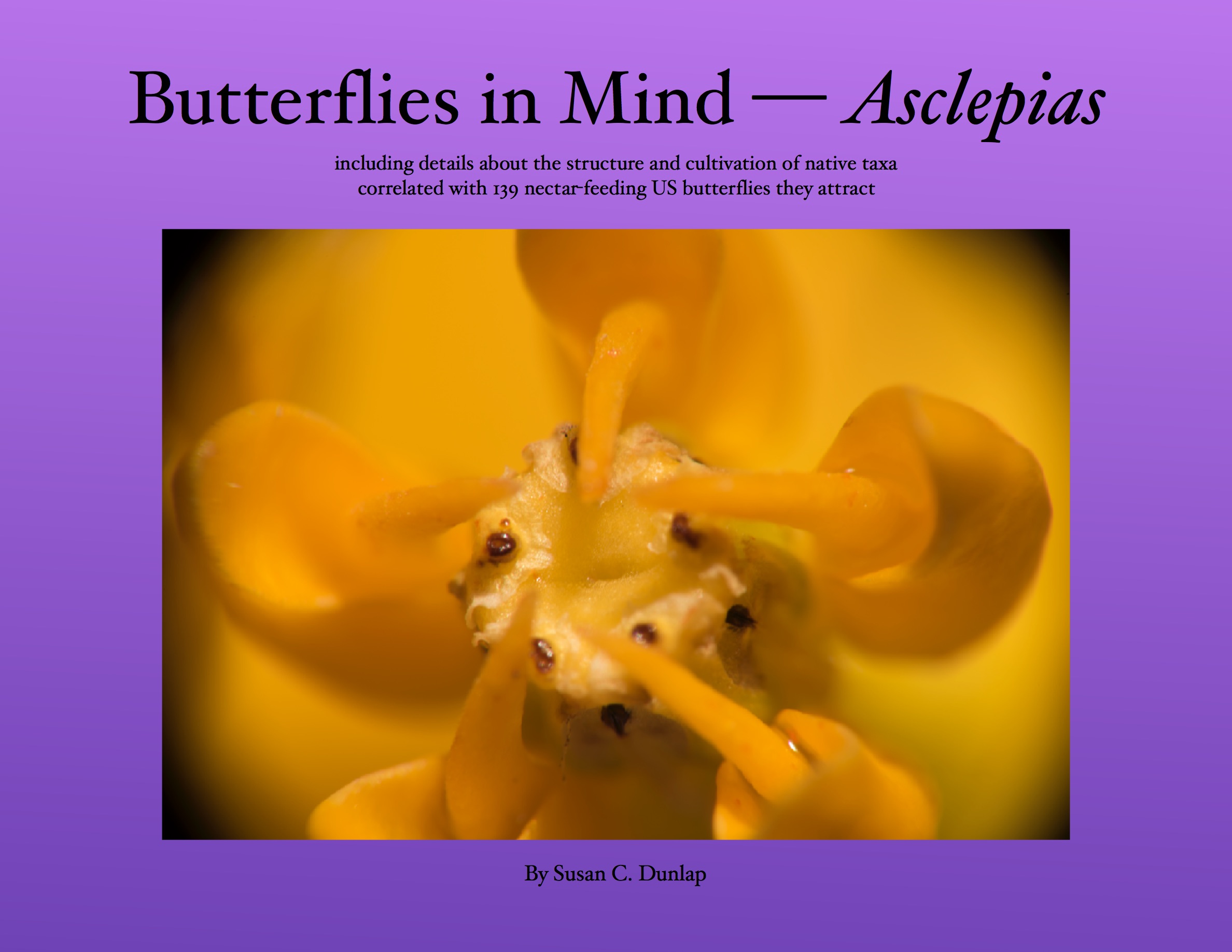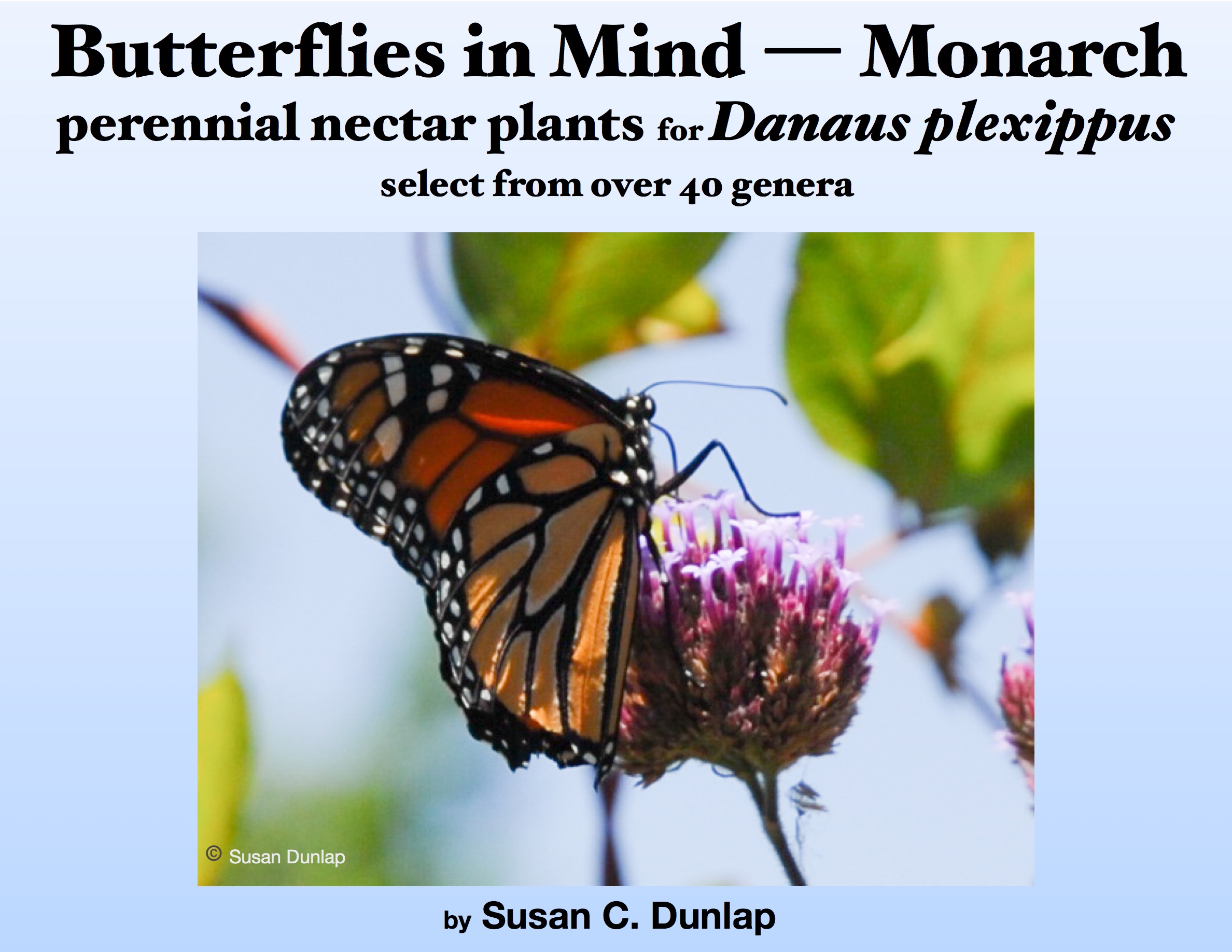Plants for gardeners who care about butterflies
657 of US butterflies — 87% — are nectar-feeding
and many will come to gardens and parks.
Links below provide comprehensive information about
plants for nectar-feeding adult US butterflies.
The 2023 UPGRADE includes data from 10,551 entries. We extracted data from a working library of over 50,000 images.
657 of US butterflies — 87% — are nectar-feeding and many will come to gardens and parks. Links below provide comprehensive information about plants for nectar-feeding adult US butterflies.
A list of the US states where each butterfly has been sighted is included in the data; as is the USDA plant zones for both cultivated and wild flora.
With this upgrade, we have added an additional 46 US butterflies to the database. The number of butterflies associated with “flower nectar” has decreased from 453 to 53 — an 88% improvement, as specific plants are now correlated with these butterflies. The number of butterflies associated with “unknown” food sources has decreased from 142 to 42 — a 71% improvement.
All of the entries were extracted from sightings recorded by citizens. Ms. Dunlap translated plant and butterfly data contained in more than 95% of these sightings. All references to butterflies associated with a particular “Plant Family” have been removed. The addition of specific plants — genera and species —has facilitated this improvement and will better assist butterfly gardeners who wish to attract and feed local butterflies.
This body of work is protected by US copyright. We are willing to collaborate with scientists and educators who share an interest in butterflies.
Butterflies that feed on nectar plants
- Abaeis nicippe "Sleepy Orange"
- Achalarus albociliatus "Skinner's Cloudywing"
- Achalarus casica "Desert Cloudywing"
- Achalarus jalapus "Pale Sicklewing"
- Achalarus lyciades "Hoary Edge"
- Achalarus toxeus "Coyote Cloudywing"
- Achlyodes pallida "Pale Sicklewing"
- Achlyodes thraso "Northern Sicklewing, Sickle-winged Skipper"
- Adopaeoides prittwitzi "Sunrise Skipper"
- Aglais milberti "Milbert's Tortoiseshell"
- Aglais urticae "Small Tortoiseshell"
- Agraulis vanillae "Gulf Fritillary"
- Agriades glandon "Glandon Blue"
- Aguna asander "Gold-spotted Aguna"
- Aguna claxon "Emerald Aguna"
- Aguna metophis "Tailed Aguna"
- Amblyscirtes oslari "Oslar's Roadside-Skipper"
- Anaea andria "Goatweed Leafwing"
- Anartia fatima "Banded Peacock"
- Anartia jatrophae "White Peacock"
- Anastrus sempiternus "Common Anastrus"
- Ancyloxypha arene "Tropical Least Skipper"
- Ancyloxypha numitor "Least Skipper"
- Anteos clorinde "White Angled Sulphur"
- Anteos maerula "Angled Sulphur"
- Anthanassa argentea "Chestnut Crescent"
- Anthanassa frisia "Cuban Crescent"
- Anthanassa texana "Texan Crescent"
- Anthocharis cethura "Desert Orangetip"
- Anthocharis cethura subsp. pima "Desert Orangetip"
- Anthocharis lanceolata "Gray Marble"
- Anthocharis midea "Falcate Orangetip"
- Anthocharis sara "Sara Orangetip"
- Anthocharis sara subsp. stella "Stella' Sara Orangetip"
- Anthocharis thoosa "Southwestern Orangetip"
- Antigonus emorsa "White Spurwing"
- Antigonus erosus "Common Spurwing"
- Aphrissa neleis "Pink-spotted Sulphur"
- Aphrissa statira "Statira Sulphur"
- Apodemia chisosensis "Chisos Metalmark"
- Apodemia hepburni "Hepburn's Metalmark"
- Apodemia mejicanus "Mexican Metalmark"
- Apodemia mormo "Mormon Metalmark"
- Apodemia nais "Nais Metalmark"
- Apodemia palmeri "Palmer's Metalmark"
- Apodemia virgulti "Behr's metalmark"
- Apodemia walkeri "Walker's Metalmark"
- Arteurotia tractipennis "Starred Skipper"
- Asbolis capucinus "Monk Skipper"
- Ascia monuste "Great Southern White"
- Asterocampa celtis "Hackberry Emperor"
- Asterocampa clyton "Tawny Emperor"
- Asterocampa leilia "Empress Leilia"
- Astraptes alardus "Frosted Flasher"
- Astraptes alector "Gilbert's Flasher"
- Astraptes anaphus "Yellow-tipped Flasher"
- Astraptes egregius "Small-spotted Flasher"
- Astraptes fulgerator "Two-barred Flasher"
- Astraptes gilberti "Gilbert's Flasher"
- Atalopedes campestris "Sachem"
- Atlides halesus "Great Purple Hairstreak"
- Atrytone arogos "Arogos Skipper"
- Atrytone deleware "Delaware Skipper"
- Atrytonopsis cestus "Python Skipper"
- Atrytonopsis deva "Deva Skipper"
- Atrytonopsis edwardsi "White-barred Skipper"
- Atrytonopsis hianna "Dusted Skipper"
- Atrytonopsis lunus "Moon-marked Skipper"
- Atrytonopsis pittacus "White-barred Skipper"
- Atrytonopsis python "Python Skipper"
- Atrytonopsis vierecki "Viereck's Skipper"
- Autochton cellus "Golden Banded-Skipper"
- Autochton cincta "Chisos Banded Skipper"
- Battus philenor "Blue Swallowtail"
- Battus polydamas "Gold-rim Swallowtail"
- Biblis hyperia "Red Rim"
- Bolla brennus "Obscure Bolla"
- Boloria bellona "Meadow Fritillary"
- Boloria chariclea "Arctic Fritillary"
- Boloria epithore "Pacific Fritillary"
- Boloria eunomia "Bog Fritillary"
- Boloria freija "Freija Fritillary"
- Boloria frigga "Frigga Fritillary"
- Boloria kriemhild "Relict Fritillary"
- Boloria selene "Silver-bordered Fritillary"
- Brephidium exilis "Western Pygmy Blue"
- Brephidium isophthalma "Eastern Pygmy Blue"
- Burnsius albezens "White Checkered-skipper"
- Burnsius communis "Common Checkered-skipper"
- Cabares potrillo "Potrillo Skipper"
- Caicella caicus "Gold-costa Skipper"
- Caicella calchas "Mimosa Skipper"
- Calephelis arizonensis "Arizona Metalmark"
- Calephelis borealis "Northern Metalmark"
- Calephelis nemesis "Fatal Metalmark"
- Calephelis perditalis "Rounded Metalmark"
- Calephelis virginiensis "Little Metalmark"
- Callicista columella subsp. istapa "Mallow Scrub Hairstreak"
- Callophrys affinis "Western Green Hairstreak"
- Callophrys apama "Arizona Canyon Green Hairstreak"
- Callophrys dumetorum "Bramble Hairstreak"
- Callophrys dumetorum subsp. perplexa "Bramble Hairstreak"
- Callophrys fotis "Desert Elfin"
- Callophrys mossii "Moss's Elfin"
- Callophrys muiri "Muir's Hairstreak"
- Callophrys thornei "Thorne's Juniper"
- Calpodes ethlius "Brazilian Skipper"
- Calycopis cecrops "Red-banded Hairstreak"
- Calycopis isobeon "Dusky-blue Groundstreak"
- Caria ino "Red-bordered Metalmark"
- Carrhenes canescens "Hoary Skipper"
- Carterocephalus palaemon "Artic Skipper"
- Catasticta nimbice "Mexican Dartwhite"
- Celaenorrhinus stallingsi "Stallings' Flat"
- Celastrina ladon "Spring Azure"
- Celastrina ladon subsp. echo "Spring Azure"
- Celastrina lucia "Northern Azure"
- Celastrina nigra "Dusky Azure"
- Celastrina serotina "Cherry Gall Azure"
- Celotes nessus "Common Streaky Skipper"
- Cercyonis meadi "Mead's Wood-Nymph"
- Cercyonis oetus "Small Wood-Nymph"
- Cercyonis pegala "Common Wood-Nymph"
- Cercyonis sthenele "Great Basin Wood-Nymph"
- Chioides catillus "White-striped Longtail"
- Chioides zilpa "Zilpa Longtail"
- Chiomara asychis subsp. georgina "White-patched Skipper"
- Chiomara mithrax "Slaty Skipper"
- Chlorostrymon simaethis "Silver-banded Hairstreak"
- Chlorostrymon telea "Telea Hairstreak"
- Chlosyne acastus "Sagebrush Checkerspot"
- Chlosyne californica "California Patch"
- Chlosyne definita "Definite Patch"
- Chlosyne endeis "Banded Patch"
- Chlosyne gabbii "Gabb's Checkerspot"
- Chlosyne gorgone "Gorgone Checkerspot"
- Chlosyne harrisii "Harris' Checkerspot"
- Chlosyne janais "Crimson Patch"
- Chlosyne lacinia "Bordered Patch"
- Chlosyne marina "Red-spotted Patch"
- Chlosyne marina subsp. melitaeoides "Red-spotted Patch"
- Chlosyne nycteis "Silvery Checkerspot"
- Chlosyne palla "Northern checkerspot"
- Chlosyne rosita "Rosita Patch"
- Codatractus alcaeus "White-crescent Longtail"
- Codatractus arizonensis "Arizona Skipper"
- Coenonympha haydenii "Hayden's Ringlet"
- Coenonympha tullia "Common Ringlet"
- Cogia hippalus "Acacia Skipper"
- Cogia hippalus subsp. outis "Acacia Skipper"
- Colias alexandra "Alexandra Sulphur"
- Colias alexandra "Alexandra Sulphur"
- Colias behrii "Behr's Sulphur"
- Colias christina "Christina's Sulphur"
- Colias eurytheme "Alfalfa"
- Colias gigantea "Giant Sulphur"
- Colias harfordii "Harford's Sulphur"
- Colias hecla "Arctic Sulphur"
- Colias interior "Pink-edged Sulphur"
- Colias meadii "Mead's Sulphur"
- Colias nastes "Labrador Sulphur"
- Colias occidentalis "Golden Sulphur"
- Colias palaeno "Artic Sulphur"
- Colias philodice "Clouded Sulphur"
- Colias scudderi "Scudder's Sulphur"
- Colias tyche "Pale Arctic Clouded Yellow"
- Conga chydaea "Hidden-ray Skipper"
- Copaeodes aurantiaca "Orange Skipperling"
- Copaeodes minima "Southern Skipperling"
- Cupido comyntas "Eastern-tailed Blue"
- Cyaniris neglecta "Summer Azure"
- Cyanophrys longula "Long-winged Greenstreak"
- Cyanophrys miserabilis "Clench's Greenstreak"
- Cyclargus thomasi "Miami Blue"
- Cymaenes odilia subsp. trebius "Fawn-spotted Skipper"
- Cymaenes tripunctus "Three-spotted Skipper"
- Danaus eresimus "Soldier"
- Danaus gilippus "Queen"
- Danaus plexippus "Monarch"
- Decinea percosius "Double-dotted Skipper"
- Dione moneta "Mexican Silverspot"
- Dircenna klugii "Klug's Clearwing"
- Dolymorpha jada "Silver Emperor"
- Doxocopa laure "Pavon Emperor"
- Doxocopa pavon "Pavon Emperor"
- Dryadula phaetusa "Banded Orange Heliconian"
- Dryas iulia "Julia Heliconian"
- Dymasia dymas "Tiny Checkerspot"
- Dynamine dyonis "Blue-eyed Sailor"
- Dynamine postverta "Mylitta greenwing"
- Echinargus isola "Reakirt's Blue"
- Electrostrymon "Muted Hairstreak"
- Elkalyce amyntula "Western Tailed-Blue"
- Emesis ares "Ares Metalmark"
- Emesis emesia "Curve-winged Metalmark"
- Emesis muticum "Swamp Metalmark"
- Emesis rawsoni "Rawson's Metalmark"
- Emesis tenedia "Falcate Metalmark"
- Emesis wrighti "Wright's Metalmark"
- Emesis zela "Zela Metalmark"
- Enantia albania "Costa-spotted Mimic-White"
- Epargyreus clarus "Silver-spotted Skipper"
- Epargyreus exadeus "Broken Silverdrop"
- Ephyriades brunnea "Florida Duskywing"
- Epidemia dorcas "Dorcas Copper"
- Erebia epipsodea "Common Alpine"
- Erebia kozhantshikovi "Reddish Alpine"
- Erebia magdalena "Magdalena Alpine"
- Erebia tyndarus "Swiss Brassy Ringlet"
- Eresia aveyrona subsp. mylitta "Mylitta Crescent"
- Erora laeta "Early Hairstreak"
- Erora quaderna "Arizona Hairstreak"
- Erynnis afranius "Afranius Duskywing"
- Erynnis baptisiae "Wild Indigo Duskywing"
- Erynnis brizo "Sleepy Duskywing"
- Erynnis funeralis "Funereal Duskywing"
- Erynnis horatius "Horace's Duskywing"
- Erynnis icelus "Dreamy Duskywing"
- Erynnis juvenalis "Juvenal's Duskywing"
- Erynnis lucilius "Columbine Duskywing"
- Erynnis meridianus "Meridian Duskywing"
- Erynnis pacuvius "Pacuvius Duskywing"
- Erynnis persius "Persius Duskywing"
- Erynnis propertius "Propertius Duskywing"
- Erynnis telemachus "Rocky Mountain Duskywing"
- Erynnis tristis "Mournful Duskywing"
- Erynnis zarucco "Zarucco Duskywing"
- Euchloe ausonides "Large Marble"
- Euchloe creusa "Northern Marble"
- Euchloe hyantis "California Marble"
- Euchloe olympia "Olympia"
- Eueides isabella "Isabella's Heliconian"
- Eumaeus atala "Atala"
- Euphilotes battoides "Square-dotted Blue"
- Euphilotes battoides subsp. centralis "Central Dotted-Blue"
- Euphilotes ellisi "Ellisi Dotted-Blue"
- Euphilotes enoptes "Dotted-Blue"
- Euphilotes enoptes subsp. ancilla "Rocky Mountain Dotted-Blue"
- Euphilotes enoptes subsp. dammersi "Pacific Dotted-Blue"
- Euphilotes intermedia "Intermediate Dotted-Blue"
- Euphilotes mojave "Mojave Dotted-Blue"
- Euphilotes rita "Rita Dotted-Blue"
- Euphilotes spaldingi "Spalding's Blue"
- Euphydryas gillettii "Gillette's Checkerspot"
- Euphydryas phaeton "Baltimore Checkerspot"
- Euphyes arpa "Palmetto Skipper"
- Euphyes bayensis "Bay Skipper"
- Euphyes berryi "Berry's Skipper"
- Euphyes bimacula "Two-spotted Skipper"
- Euphyes conspicua "Black Dash"
- Euphyes dion "Dion Skipper"
- Euphyes dukesi "Dukes' Skipper"
- Euphyes pilatka "Palatka Skipper"
- Euphyes vestris "Dun Skipper"
- Euptoieta claudia "Variegated Fritillary"
- Euptoieta hegesia "Mexican Fritillary"
- Euptychia phocion "Georgia Satyr"
- Euptychia pyracmon "Nabokov's Satyr"
- Eurema boisduvaliana "Boisduval's Yellow"
- Eurema daira "Barred Yellow"
- Eurema lisa "Little Yellow"
- Eurema mexicana "Mexican Yellow"
- Eurema salome "Salome Yellow"
- Eyphyes conspicua "Black Dash"
- Fixsenia favonius "Oak Hairstreak"
- Fixsenia polingi "Poling's Hairstreak"
- Ganyra howarthi "Howarth's White"
- Ganyra josephina "Giant White"
- Gesta gesta subsp. invisus "False Duskywing"
- Glaucopsyche lygdamus "Silvery Blue"
- Glaucopsyche piasus "Arrowhead Blue"
- Glutophrissa drusilla "Florida White"
- Gorgythion begga "Variegated Skipper"
- Grais stigmaticus "Hermit Skipper"
- Greta morgane "Morgane Clearwing"
- Gyrocheilus patrobas "Red-bordered Satyr"
- Habrodais grunus "Golden Hairstreak"
- Heliconius charithonia "Zebra Heliconian"
- Heliconius erato "Erato Heliconian"
- Heliconius melpomene "Postman"
- Heliopetes arsalte "Veined White-Skipper"
- Heliopetes ericetorum "Northern White-Skipper"
- Heliopetes laviana "Laviana White-Skipper"
- Heliopetes macaira "Turk's-cap White-Skipper"
- Heliopetes sublinea "Erichson's White-Skipper"
- Heliopyrgus domicella "East-Mexican White-Skipper"
- Heliopyrgus sublinea "Erichson's White-Skipper"
- Hemiargus ceraunus "Ceraunus Blue"
- Hermeuptychia hermes "Hermes Satyr"
- Hesperia attalus "Dotted Skipper"
- Hesperia columbia "Columbian Skipper"
- Hesperia comma "Common Branded Skipper"
- Hesperia comma subsp. colorado "Western Branded Skipper"
- Hesperia dacotae "Dakota Skipper"
- Hesperia juba "Juba Skipper"
- Hesperia leonardus "Leonard's Skipper"
- Hesperia lindseyi "Lindsey's Skipper"
- Hesperia meskei "Meske's Skipper"
- Hesperia metea "Cobweb Skipper"
- Hesperia miriamae "Sierra Skipper"
- Hesperia nevada "Nevada Skipper"
- Hesperia ottoe "Ottoe Skipper"
- Hesperia pahaska "Pahaska Skipper"
- Hesperia sassacus "Indian Skipper"
- Hesperia uncas "Uncas Skipper"
- Hesperia viridis "Green Skipper"
- Hesperia woodgatei "Apache Skipper"
- Hesperopsis alpheus "Saltbush Sootywing"
- Historis odius "Orion Cecropian"
- Hylephila phyleus "Fiery Skipper"
- Hypaurotis crysalus "Colorado Hairstreak"
- Hypolimnas misippus "Danaid Eggfly"
- Hypostrymon critola "Sonoran Hairstreak"
- Icaricia icarioides "Boisduval's Blue"
- Icaricia saepiolus "Greenish Blue"
- Incisalia eryphon "Western Pine Elfin"
- Incisalia henrici "Henry's Elfin"
- Incisalia irioides "Western Elfin"
- Incisalia lanoraieensis "Bog Elfin"
- Incisalia niphon "Eastern Pine Elfin"
- Itaballia demophile "Mountain White"
- Junonia coenia "Common Buckeye"
- Junonia evarete "Tropical Buckeye"
- Kricogonia lyside "Lyside Sulphur"
- Lampides boeticus "Long-tailed Blue"
- Lasaia sula "Blue Metalmark"
- Leptophobia aripa "Mountain White"
- Leptotes cassius "Cassius Blue"
- Leptotes marina "Marine Blue"
- Lerema accius "Clouded Skipper"
- Lerodea arabus "Olive-clouded Skipper"
- Lerodea eufala "Eufala Skipper"
- Lethe eurydice "Eyed Brown"
- Lethe eurydice subsp. appalachia "Eyed Brown"
- Libytheana carinenta "American Snout"
- Limenitis archippus "Viceroy"
- Limenitis arthemis "Red-spotted Purple"
- Limenitis bredowii subsp. californica "Band-celled Sister"
- Limenitis fessonia "Band-celled Sister"
- Limenitis lorquini "Lorquin's Admiral"
- Limenitis weidemeyerii "Weidemeyer's Admiral"
- Lon hobomok "Hobomok Skipper"
- Lon melane "Umber Skipper"
- Lon taxiles "Taxiles Skipper"
- Lon zabulon "Zabulon Skipper"
- Lycaeides idas "Idas Blue"
- Lycaeides melissa "Melissa Blue"
- Lycaena arota "Tailed Copper"
- Lycaena cupreus "Lustrous Copper"
- Lycaena cyna "Cyna Copper"
- Lycaena dione "Gray Copper"
- Lycaena editha "Edith's Copper"
- Lycaena epixanthe "Bog Copper"
- Lycaena gorgon "Gorgon Copper"
- Lycaena helloides "Purplish Copper"
- Lycaena heteronea "Blue Copper"
- Lycaena hyllus "Bronze Copper"
- Lycaena mariposa "Mariposa Copper"
- Lycaena nivalis "Lilac-bordered Copper"
- Lycaena phlaeas "American Copper"
- Lycaena rubidus "Ruddy Copper"
- Lycaena xanthoides "Great Copper"
- Marpesia chiron "Many-banded Daggerwing"
- Marpesia eleuchea "Antillean Daggerwing"
- Marpesia petreus "Ruddy Daggerwing"
- Mastor aenus "Bronze Roadside Skipper"
- Mastor aenus subsp. linda "Linda's Roadside-Skipper"
- Mastor aesculapius "Lace-winged Roadside Skipper"
- Mastor alternata "Dusky Roadside Skipper"
- Mastor carolina "Carolina Roadside Skipper"
- Mastor cassus "Cassus Roadside Skipper"
- Mastor celia "Celia's Roadside Skipper"
- Mastor celia subsp. belli "Bell's Roadside Skipper"
- Mastor elissa "Dotted Roadside Skipper"
- Mastor exoteria "Large Roadside Skipper"
- Mastor fimbriata "Orange-edged Roadside Skipper"
- Mastor hegon "Pepper and Salt Skipper"
- Mastor nereus "Slaty Roadside Skipper"
- Mastor nysa "Nysa Roadside Skipper"
- Mastor phylace "Orange-headed Roadside Skipper"
- Mastor simius "Simis Roadside Skipper"
- Mastor texanae "Texas Roadside Skipper"
- Mastor tolteca "Prenda Roadside-Skipper"
- Mastor vialis "Common Roadside-Skipper"
- Melanis pixe "Red-bordered Pixie"
- Melete lycimnia "Common Melwhite"
- Mellana eulogius "Common Mellana"
- Mestra amymone "Common Mestra"
- Microtia elva "Elf"
- Mimoides phaon "Variable Swallowtail"
- Ministrymon azia "Gray Ministreak"
- Ministrymon clytie "Clytie Ministreak"
- Mitoura gryneus "Juniper Hairstreak"
- Mitoura hesseli "Hessel's Hairstreak"
- Mitoura spinetorum "Thicket Hairstreak"
- Monca crispinus "Violet-patched Skipper"
- Murgaria albociliatus "Skinner's Cloudywing"
- Mylon pelopidas "Hoary Skipper"
- Nastra julia "Julia's Skipper"
- Nastra lherminier "Swarthy Skiper"
- Nastra neamathla "Neamathla Skipper"
- Nathalis iole "Dainty Sulphur"
- Neominois ridingsii "Ridings' Satyr"
- Neonympha helicta "Helicta Satyr"
- Neonympha mitchellii "Mitchell's Satyr"
- Neophasia menapia "Pine White"
- Noctuana stator "Red-studded Skipper"
- Nyctelius nyctelius "Violet-banded Skipper"
- Nymphalis antiopa "Mourning Cloak"
- Nymphalis californica "California Tortoiseshell"
- Oarisma edwardsii "Edwards' Skipperling"
- Oarisma garita "Garita Skipperling"
- Oarisma poweshiek "Poweshiek Skipperling"
- Occidryas anicia "Anicia Checkerspot"
- Occidryas chalcedona "Chalcedon Checkerspot"
- Occidryas colon "Colon Checkerspot"
- Occidryas editha "Edith's Checkerspot"
- Ochlodes agricola "Rural Skipper"
- Ochlodes snowi "Snow's Skipper"
- Ochlodes sylvanoides "Woodland Skipper"
- Ochlodes sylvanoides subsp. yuma "Yuma Skipper"
- Oeneis alberta "Alberta Arctic"
- Oeneis chryxus "Chryxus Arctic"
- Oeneis jutta "Jutta Arctic"
- Oeneis nevadensis "Great Arctic"
- Oeneis uhleri "Uhler's Arctic"
- Oenomaus ortygnus "Aquamarine Hairstreak"
- Oligoria maculata "Twin-spot Skipper"
- Panoquina errans "Wandering Skipper"
- Panoquina fusina subsp. evansi "Evans' Skipper"
- Panoquina hecebolus "Hecebolus Skipper"
- Panoquina ocola "Ocola Skipper"
- Panoquina panoquin "Salt Marsh Skipper"
- Panoquina panoquinoides "Obscure Skipper"
- Panoquina sylvicola "Purple-washed Skipper"
- Papilio anchisiades "Ruby-spotted Swallowtail"
- Papilio andraemon "Androgeus Swallowtail"
- Papilio appalachiensis "Appalachian Tiger Swallowtail"
- Papilio aristodemus "Schaus' Swallowtail"
- Papilio astyalus "Astyalus Swallowtail"
- Papilio canadensis "Canadian Tiger Swallowtail"
- Papilio cresphontes "Giant Swallowtail"
- Papilio eurymedon "Pale Swallowtail"
- Papilio glaucus "Eastern Tiger Swalowtail"
- Papilio indra "Indra Swallowtail"
- Papilio machaon "Artemisia Swallowtail"
- Papilio machaon subsp. bairdii "'Baird's' Old World Swallowtail"
- Papilio menatius "Menatius Swallowtail"
- Papilio multicaudata "Two-tailed Swallowtail"
- Papilio ornythion "Ornythion Swallowtail"
- Papilio palamedes "Palamedes Swallowtail"
- Papilio polyxenes "Black Swallowtail"
- Papilio rogeri "Pink-spotted Swallowtail"
- Papilio rumiko "Western Giant Swallowtail"
- Papilio rutulus "Western Tiger Swallowtail"
- Papilio thoas "Thoas Swallowtail"
- Papilio troilus "Spicebush Swallowtail"
- Papilio victorinus "Victorine Swallowtail"
- Papilio xuthus "Asian swallowtail"
- Papilio zelicaon "Anise Swallowtail"
- Parnassius clodius "Clodius Parnassian"
- Parnassius eversmanni "Eversmann's Parnassian"
- Parnassius phoebus "Small Apollo"
- Parrhasius m-album "White-M Hairstreak"
- Pellicia costimacula subsp. arina "Glazed Pellicia"
- Pellicia dimidiata "Morning Glory Pellicia"
- Perichares philetes "Green-backed Ruby-eye"
- Phaeostrymon alcesti "Soapberry Hairstreak"
- Philotes bernardino "Bernardino Dotted Blue"
- Philotes sonorensis "Sonoran Blue"
- Philotiella speciosa "Small Blue"
- Phocides pigmalion "Mangrove Skipper"
- Phocides polybius "Guava Skipper"
- Phoebis agarithe "Large Orange Sulphur"
- Phoebis neocypris "Tailed Sulphur"
- Phoebis philea "Orange-barred Sulphur"
- Phoebis sennae "Cloudless Sulphur"
- Pholisora catullus "Common Sootywing"
- Pholisora gracielae "MacNeill's Sootywing"
- Pholisora libya "Mojave Sootywing"
- Pholisora mejicanus "Mexican Sootywing"
- Phyciodes batesii "Tawny Crescent"
- Phyciodes orseis "California Crescent"
- Phyciodes pallida "Pale Crescent"
- Phyciodes phaon "Phaon Crescent"
- Phyciodes picta "Painted Crescent"
- Phyciodes picta subsp. pallescens "Mexican Crescent"
- Phyciodes tharos "Pearl Crescent"
- Phyciodes vesta subsp. graphica "Vesta Crescent"
- Pieris angelika "Arctic White"
- Pieris marginalis "Margined White"
- Pieris napi "Green-veined white"
- Pieris oleracea "Mustard White"
- Pieris rapae "Cabbage White"
- Pieris virginiensis "West Virginia White"
- Piruna aea "Many-spotted Skipperling"
- Piruna pirus "Russet Skipperling"
- Piruna polingii "Four-spotted Skipperling"
- Plebejus acmon "Acmon Blue"
- Plebejus anna "Anna's Blue"
- Plebejus emigdionis "San Emigdio Blue"
- Plebejus fridayi "Friday's Blue"
- Plebejus lupini "Lupine Blue"
- Plebejus saepiolus "Greenish Blue"
- Plebejus shasta "Shasta Blue"
- Poanes aaroni "Aaron's Skipper"
- Poanes massasoit "Mulberry Wing"
- Poanes viator "Broad-winged Skipper"
- Poanes yehl "Yehl Skipper"
- Poladryas minuta "Dotted Checkerspot"
- Polites baracoa "Baracoa Skipper"
- Polites coras "Peck's Skipper"
- Polites mystic "Long Dash"
- Polites origenes "Crossline Skipper"
- Polites sabuleti "Sandhill Skipper"
- Polites themistocles "Tawny-edged Skipper"
- Polites vibex "Whirlabout"
- Polygonia comma "Eastern Comma"
- Polygonia faunus "Faunus Comma"
- Polygonia gracilis "Hoary Comma"
- Polygonia interrogationis "Question mark"
- Polygonia oreas "Oreas Comma"
- Polygonia progne "Gray Comma"
- Polygonia satyrus "Satyr Comma"
- Polygonus leo "Hammock Skipper"
- Polygonus savigny "Manuel's Skipper"
- Polythrix octomaculata "Eight-spotted Longtail"
- Pompeius verna "Little Glassywing"
- Pontia beckerii "Becker's White"
- Pontia occidentalis "Western White"
- Pontia protodice "Checkered White"
- Pontia sisymbrii "Spring White"
- Problema bulenta "Rare Skipper"
- Problema byssus "Byssus Skipper"
- Proteides mercurius "Mercurial Skipper"
- Protographium marcellus "Zebra Swallowtail"
- Protographium philolaus "Dark Kite-Swallowtail"
- Pseudocopaeodes eunus "Alkali Skipper"
- Pteronymia cotytto "Cotytto Clearwing"
- Pyrgus centaureae "Grizzled Skipper"
- Pyrgus communis "Common Checkered-Skipper"
- Pyrgus oileus "Tropical Checkered-Skipper"
- Pyrgus ruralis "Small Checkered-Skipper"
- Pyrgus scriptura "Mountain Checkered-Skipper"
- Pyrisitia dina "Dina Yellow"
- Pyrisitia lisa "Little Yellow"
- Pyrisitia nise "Mimosa Yellow"
- Pyrisitia proterpia "Tailed Orange"
- Pyrrhopyge araxes "Dull Firetip"
- Rhinthon cubana subsp. osca "Osca Skipper"
- Sandia mcfarlandi "Sandia Hairstreak"
- Satyrium acadica "Acadian Hairstreak"
- Satyrium behrii "Behr's Hairstreak"
- Satyrium calanus "Banded Hairstreak"
- Satyrium caryaevorus "Hickory Hairstreak"
- Satyrium edwardsii "Edwards' Hairstreak"
- Satyrium fuliginosa "Sooty Hairstreak"
- Satyrium fuliginosa subsp. semiluna "Sagebrush Sooty Hairstreak"
- Satyrium liparops "Striped Hairstreak"
- Satyrium titus "Coral Hairstreak"
- Siproeta stelenes "Malachite"
- Spathilepia clonius "Falcate Skipper"
- Speyeria adiaste "Unsilvered Fritillary"
- Speyeria aphrodite "Aphrodite Fritillary"
- Speyeria atlantis "Atlantis Fritillary"
- Speyeria atlantis subsp. hesperis "Atlantis Fritillary"
- Speyeria callippe "Callippe Silverspot"
- Speyeria coronis "Coronis Fritillary"
- Speyeria cybele "Great Spangled Fritillary"
- Speyeria diana "Diana Fritillary"
- Speyeria edwardsii "Edwards' Fritillary"
- Speyeria egleis "Great Basin Fritillary"
- Speyeria hydaspe "Hydaspe Fritillary"
- Speyeria idalia "Regal Fritillary"
- Speyeria nokomis "Nokomis Fritillary"
- Speyeria zerene "Zerene Fritillary"
- Staphylus ceos "Golden-headed Scallopwing"
- Staphylus mazans "Mazans Scallopwing"
- Staphylus mazans subsp. hayhurstii "Hayhurst's Scallopwing"
- Stinga morrisoni "Morrison's Skipper"
- Strymon acis "Bartram's Scrub-Hairstreak"
- Strymon albata "White Scrub-Hairstreak"
- Strymon alea "Lacey's Scrub-Hairstreak"
- Strymon avalona "Avalon Scrub-Hairstreak"
- Strymon bazochii "Lantana Scrub-Hairstreak"
- Strymon kingi "King's Hairstreak"
- Strymon melinus "Gray Hairstreak"
- Strymon saepium "Hedgerow Hairstreak"
- Strymon sylvinus "Sylvan Hairstreak"
- Synapte malitiosa "Synapte malitiosa"
- Systasea pulverulenta "Texas Powdered Skipper"
- Systasea zampa "Arizona Powdered Skipper"
- Texola elada "Elada Checkerspot"
- Thecla angelia "Fulvous Hairstreak"
- Thecla bathildis "Zebra-striped Hairstreak"
- Thecla bebrycia "Red-lined Scrub-Hairstreak"
- Thecla goodsoni "Tropical Greenstreak"
- Thecla herodotus "Tropical Greenstreak"
- Thecla ilavia "Ilavia Hairstreak"
- Thecla irus "Frosted Elfin"
- Thecla johnsoni "Johnson's Hairstreak"
- Thecla joya "Muted Hairstreak"
- Thecla maesites "Verde Azul Hairstreak"
- Thecla marius "Marius Hairstreak"
- Thecla rufofusca "Red-crescent Scrub-Hairstreak"
- Thecla sangala "Ruddy Hairstreak"
- Thecla serapio "Bromeliad Scrub-Hairstreak"
- Thecla sheridanii "Sheridan's Green Hairstreak"
- Thecla strophius "Strophius Hairstreak"
- Thecla tetra "Mountain Mahogany Hairstreak"
- Thecla yojoa "Yojoa Scrub-Hairstreak"
- Thespieus macareus "Chestnut-marked Skipper"
- Thessalia leanira "Fulvia Checkerspot"
- Thessalia theona "Theona Checkerspot"
- Thorybes daunus "Southern Cloudywing"
- Thorybes drusius "Drusius Cloudywing"
- Thorybes mexicana "Mexican Cloudywing"
- Thorybes mexicanus subsp. confusis "Confused Cloudywing"
- Thorybes pylades "Northern Cloudywing"
- Thymelicus lineola "Essex Skipper"
- Timochares ruptifasciata "Brown-banded Skipper"
- Tmolus echion "Red-spotted Hairstreak"
- Turesis lucas "Purple-washed Skipper"
- Typhedanus undulatus "Mottled Longtail"
- Udara blackburni "Blackburn's Blue"
- Urbanus dorantes "Dorantes longtail"
- Urbanus doryssus "White-tailed Longtail"
- Urbanus esmeraldus "Esmeralda Longtail"
- Urbanus procne "Brown Longtail"
- Urbanus pronus "Pronus Longtail change in CSV"
- Urbanus proteus "Long-tailed Skipper"
- Urbanus simplicius "Plain Longtail"
- Urbanus tanna "Tanna Longtail"
- Urbanus teleus "Teleus Longtail"
- Vacciniina optilete "Cranberry Blue"
- Vanessa annabella "West Coast Lady"
- Vanessa atalanta "Red Admiral"
- Vanessa cardui "Painted Lady"
- Vanessa virginiensis "American Lady"
- Vernia verna "Little Glassywing"
- Vidius perigenes "Pale-rayed Skipper"
- Wallengrenia egeremet "Northern Broken-Dash"
- Wallengrenia otho "Southern Broken-Dash"
- Xamia xami "Xami Hairstreak"
- Xenophanes tryxus "Glassy-winged Skipper"
- Yvretta carus "Carus Skipper"
- Zerene cesonia "Southern Dogface"
- Zerene eurydice "California Dogface"
- Zestusa dorus "Short-tailed Skipper"







